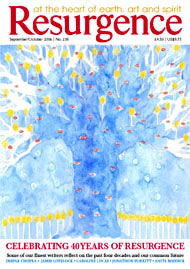RESURGENCE IS A CHILD of the sixties. Rachel Carson's Silent Spring came out in 1962 and alerted us to the plight of the Earth. At that time I was walking with a friend from India to Moscow, Paris, London and Washington for peace. I soon realised that unless we make peace with the Earth there can be no peace among humans.
E. F. Schumacher, Leopold Kohr, Ivan Illich, John Seymour and Barbara Ward were all thinking on the same wavelength but it fell upon John Papworth, who walked with me in the USA, to conceive the idea of a forum which would bring together all the holistic thinkers and great activists of that time. Thus Resurgence was born; to connect world peace with inner peace and peace with the planet.
When John and I walked together in the streets and neighbourhoods of the American cities we heard the songs of John Lennon, Joan Baez and Bob Dylan. We participated in the protests against the Vietnam War, we joined the Civil Rights marchers led by Martin Luther King in Albany and Atlanta and we talked about a holistic worldview in which humanity and the Earth are in harmony.
Soon after Resurgence was launched in 1966, Edward (Teddy) Goldsmith started The Ecologist and published A Blueprint for Survival, which was endorsed by many scientists, politicians and social activists. The Blueprint became a catalyst to inspire and activate a whole generation of civil society. I became spellbound by Teddy and his ecological worldview.
In 1972 Teddy and I went to Stockholm to participate in the first ever UN conference on the environment. There, Limits to Growth was launched and a new energy was unleashed which was felt around the world.
While the Blueprint and Limits produced political awareness, E. F. Schumacher's Small is Beautiful gave a philosophical, spiritual and economic grounding to the environmental movement. It was at this time, in 1973, that my wife June and I accepted John Papworth's invitation to become editors of Resurgence. Fritz Schumacher gave his backing to my editorship by saying, "There are many Gandhians in India; we need one here in England." To which I countered, "I am prepared to edit if you agree to write in every issue." Which he did until his death in 1976.
Then, with the backing of Resurgence readers and contributors, the E. F. Schumacher Society, the Schumacher Lectures, the Small School, Green Books and eventually Schumacher College were established to carry on the work of bringing ecology, spirituality and social justice together.
While Resurgence grew slowly and steadily, the environmental movement went from strength to strength: Friends of the Earth, Greenpeace and a number of Green parties around the world became the platform for the millions of activists. Gaia Theory, Deep Ecology, Organic Farming, Self-Sufficiency, Back to the Land, Renewable Energy, Community Technology, Farmers' Markets, Vegetable Box Schemes, Permaculture, Bioregionalism and Localism were some of the expressions of a new ecological worldview, which the environmental movement championed and Resurgence magazine represented.
IN THE PAST forty years the paradigm has shifted. Now The Independent newspaper runs cover stories on the environment, arch consumer magazine Vanity Fair has produced a special issue proclaiming "Green is the New Black" and even the UK Conservative Party ran its local election campaign on the motto "Vote Blue, Get Green". These are signs of changing times which give us a cause for optimism. If the trend continues in favour of environmental sustainability then the shift in political priorities and policies is bound to follow. But to make sure that they do, green groups and eco-activists have to join forces and work together.
The past forty years have laid the foundations for a better future. Now we need to build on those foundation so that the coming generations can enjoy sustainable living. The many groups of the environmental movement show strength in diversity but it is essential that, whatever single issue we are focusing on, we hold the big picture in our minds. The time has come when separate and disparate groups must stand together. Alone we are weak but together we are strong and we can change the world. Resurgence represents the united voice of the environmental movement.
On the 16th September Resurgence is celebrating its 40th anniversary. Leading environmental organisations, activists and thinkers are joining hands to celebrate the Earth and all those who are committed to her wellbeing. This gathering gives me confidence that in the future we will be able to complement and collaborate in a similar manner. The holistic movement in itself should not be fragmented.
To mark the 40th anniversary we are offering our readers this special issue which is different from our normal issues. We asked our celebrated contributors to tell us their personal stories and perspectives so that we know how they have contributed to the environmental narrative of the past forty years. So here we have some of the most inspiring tales which have shaped the thoughts and actions of a movement that is addressing the most urgent challenges of our time. May these stories stimulate our readers and inspire them to live well and act well.







